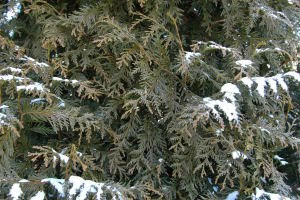 No one would ever accuse me of being a fan of Emerald Green Arborvitae, at least not for the front range of Colorado. They are not particularly drought tolerant, realtively slower growing, explode in heavy snow, burn from sun and wind as well as being the epitome of a commodity product. All this being said, there is an arborvitae on the market I am excited about. Thuja standishii x plicata, Green Giant arborvitae is a National Arboretum elite plant that is tolerant of a wide variety of soils and is hardy to Zone 5. This plant can be used as an evergreen screen, hedge or as a single specimen.
No one would ever accuse me of being a fan of Emerald Green Arborvitae, at least not for the front range of Colorado. They are not particularly drought tolerant, realtively slower growing, explode in heavy snow, burn from sun and wind as well as being the epitome of a commodity product. All this being said, there is an arborvitae on the market I am excited about. Thuja standishii x plicata, Green Giant arborvitae is a National Arboretum elite plant that is tolerant of a wide variety of soils and is hardy to Zone 5. This plant can be used as an evergreen screen, hedge or as a single specimen.'Green Giant' is virtually maintence free, pest and disease resistant and widely considered deer resistant (al
 l deer will graze on something green when they are starving). 'Green Giant' is a very fast growing plant regularly putting on 12-24" of grown annually and even more in some climates. The size of the plants at 10 years is 18-20' tall and 8' wide. Mature height is said to be upwards of 60' tall and 30' wide, although I wouldn't expect quite that large here. The plant is a little more "open" in habit, that is relative to Emerald Green, so that it sheds ice and snow well without breakage.
l deer will graze on something green when they are starving). 'Green Giant' is a very fast growing plant regularly putting on 12-24" of grown annually and even more in some climates. The size of the plants at 10 years is 18-20' tall and 8' wide. Mature height is said to be upwards of 60' tall and 30' wide, although I wouldn't expect quite that large here. The plant is a little more "open" in habit, that is relative to Emerald Green, so that it sheds ice and snow well without breakage.I planted a small screen of 5 plants in my yard about two years ago as #7's that were maybe 50" tall. They have full south sun exposure and are planted on my property line in an area that is a small drainage swail. Today they stand about 8' to the tip and are nice and full plants. It is important to select trees with a strong central leader. 'Green Giant' will tend to stretch some at the top with a kind of leggy appearance above the body of the plant. There is a selection of 'Green Giant' called 'Steeplechase' which does not thow this longer leader up, but it is not widely available yet outside of the east coast. I have observed that the dormant color can be quite dull and last winter I saw some sunburn on foliage on the south side but the plant has grown right out of it nicely and held up well with the record setting dry winter. With the onset of many insect problems in our pine and spruce populations, there certainly is room for this plant along the Front Range.

No comments:
Post a Comment